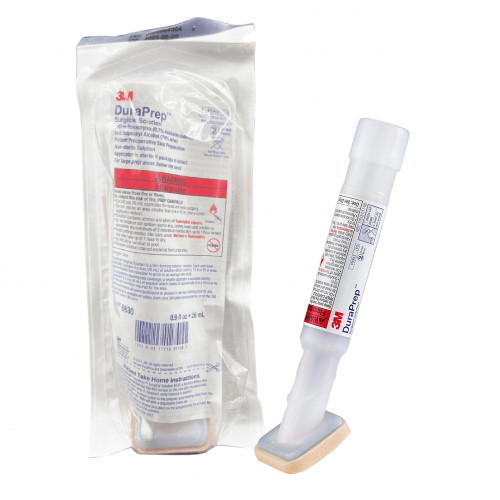-

McKesson
McKesson Alcohol Dispenser Reusable Clear 9 oz.
Handy bottle is excellent for dispensing isopropyl alcohol and other cleaners and solvents.Without imprint Unique push down dispensing design prevents cross contamination, not allowing dispensed fluid to return to bottle Locking cap prevents fluid from...
$17.93 -

3M
3M DuraPrep Isopropyl Alcohol Skin Prep Solution
Protect against infection from skin incisions with a coating of 3M™ Duraprep™ Surgical Prepping Solution. It comes in an angled applicator with a large sponge head for quickly creating a widespread, even layer. As 3M™ Duraprep™ surgical solution dries,...
$180.89 -
 $29.09
$29.09 -

McKesson
McKesson 0.9% Irrigation Solution - OTC 120 mL Sterile 48 per Case
Package Count: 48. McKesson sterile saline is designed for use in the irrigation of devices. Formulated with 0.9% sodium chloride, it is sterilized through a gamma radiation process. This method allows McKesson sterile saline to meet or exceed USP...
$50.09 -

StayStrips
StayStrips Flexible Skin Closure Strip Sterile
StayStrips Wound Closure Strips are flexible, porous strips with a reliable, hypoallergenic adhesive that allows skin to breathe while providing general wound support Conforms to wound edges Moisture and air permeable Helps reduce scar formation
As low as $26.36 -

Esenta Sting Free
Esenta Sting Free, Adhesive Remover Spray, Silicone-Based, 50 mL
Esenta Remover quickly and easily releases adhesives associated with the care of colostomies, ileostomies and urostomies. It also removes adhesive residue left by appliances, transdermal patches and wound care items. Pain is reduced, residue is...
As low as $28.86 -

McKesson
McKesson 70% Isopropyl Alcohol Antiseptic 60 per Case
Package Count: 60. Hydrox isopropyl alcohol topical solution is a great addition to first aid kit. The topical solution is made with 70% isopropyl rubbing alcohol to suit a wide variety of first aid needs.Rubbing alcohol can be used on minor cuts and...
$56.69 -

McKesson
McKesson Irrigation Solution, Sterile Water, Screw Top
McKesson sterile water for irrigation solution is a liquid that is used for cleaning wounds, moistening wound dressings and device irrigation. This sterile irrigation water comes sterilized and is intended only for sterile irrigation, washing, rinsing...
As low as $8.36 -

Cardinal Health
Cardinal Health Alcohol Prep Pads, Nonwoven Material, Sterile, Large
Meets the USP testing requirements for purified water Compatible with CHG Soft, non-woven pads provide excellent absorbency Used as a topical antiseptic; preparing skin for injections
As low as $13.12 -

McKesson
Irrigation Solution McKesson Sodium Chloride Not for Injection, Bottle Screw Top
Use this premium-grade McKesson USP normal saline for wound care needs in a variety of medical settings. This 0.9% sodium chloride irrigation solution comes in a screw-top bottle that keeps the contents sterile until it is opened. You can use this USP...
As low as $9.35 -

Hollister
Adapt Adhesive Remover Spray
Hollister's Adapt medical adhesive remover spray is silicone-based with an alcohol-free formulation to deliver an efficient solution for skin barrier removal. There is no sting caused by alcohol and contains no CFCs. These medical supplies are not made...
$17.60 -

IV PREP
IV PREP Alcohol Pad - Sterile, Isopropyl Alcohol Prep Pad, 2 in x 2 in
IV PREP Antiseptic Wipes come in a convenient, single use package. This antiseptic wipe is designed to sterilize and prepare skin prior to a venipuncture or injection. The Smith & Nephew IV PREP Wipes are easy-to-apply, highly effective, quick drying,...
As low as $19.63
Wound & Skin Prep

Whether you are taking care of someone prone to wounds or are stocking up in case of an accident, having the appropriate supplies is critical. If you see your healthcare provider, they will give you recommendations about how to care for the wound and the surrounding skin. Here is what you need to know about wound and skin prep supplies.
Wound and skin prep is an integral part of wound care and occurs before applying dressings or bandages. The wound and the surrounding skin also need cleaning in between dressing applications. You should clean and debride (remove all foreign material and dead or contaminated tissue) a wound, before applying a dressing; wound closures may also be helpful for deep cuts. Clean older wounds of any fluid, gauze, or bandage adhesive stuck to the skin.
Several materials are essential to have on hand for proper wound and skin prep.
Cleansers: Keeping the wound clean is perhaps one of the most important aspects of wound care. There are many different types of wound cleansers available, including:
Alginates: For wounds that require additional moisture and protection from contaminants, you can use alginate in addition to standard dressing. Wounds that require alginates may include surgical wounds, pressure ulcers, and partial thickness burns. Alginates are available as gels or skin barrier wipes.
Wound Closures: Deep cuts may require help closing via wound closure strips. The strips help pull together the edges of the wound to encourage closure.
Adhesive Removers: Adhesive removers help remove any adhesive materials from prior dressings or bandages on the skin around the wound. This prevents sticky buildup on the skin that is around the wound and ensures good adhesion of the new bandage or dressing. There are several types of adhesive removers, including:
Wound and skin prep are essential parts of wound care and should be performed with care. If a wound is not healing properly or if you suspect complications, seek the advice of a medical professional as soon as possible.
